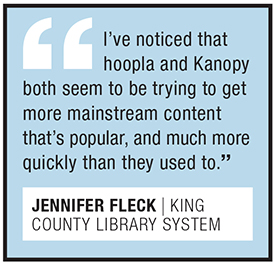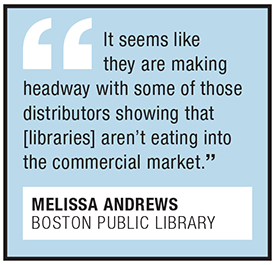Full Stream Ahead: The State of Library Streaming Services
Library entertainment platforms offering movies and TV shows gain on commercial streaming services as consumers balk at subscription costs. With “subscription fatigue” on the rise, libraries are seeing a growing popularity in streaming services—and deciding how best to provide them.
 |
Illustration by John W. Tomac |
Library entertainment platforms offering movies and TV shows gain on commercial streaming services as consumers balk at subscription costs
Streaming has become ubiquitous in the United States. According to a demographically diverse survey of 1,000 people by market research company OnePoll and Forbes Home published in February, Americans now spend, on average, a little over three hours per day streaming various forms of digital media. Ninety-nine percent of respondents said they have a subscription to at least one streaming service, with Netflix the most popular paid service for streaming movies and TV shows. However, global consultancy Simon-Kucher notes in its most recent Global Streaming Study, published in July 2023, that “subscription fatigue” is on the rise, with the overall budget people are willing to spend on streaming services declining.
Subscription fatigue is leading to two separate trends. The average number of streaming services per consumer declined by 13 percent in the United States between 2022 and 2023, with people becoming more inclined to cancel an existing subscription if they add a new one. And free ad-supported services, such as Amazon’s Freevee, are becoming more popular for movies and TV shows, according to the Simon-Kucher report. Free services now account for 36 percent of the total time people around the world spend streaming, up from 29 percent in 2022. These trends could be partly responsible for the growing popularity of library streaming services such as hoopla, Kanopy, and Bibliotheca’s cloudLibrary streaming video, which launched as biblio+ in October 2021.
GREAT GROWTH
OverDrive’s Kanopy streaming video service achieved new records in 2023, adding 3.6 million new users, representing 6 percent growth over 2022; 13 million hours watched, up 14 percent; and 24 million total plays, up 9 percent. While those numbers are global, OverDrive President and CEO Steve Potash explains that “North America still dominates our business, but the growth was pretty much universal…. What is driving that is new libraries signing up, or more users finding out about Kanopy from libraries marketing it well. It varies by territory and audience.”
Hoopla also “had a great year,” says Jeff Jankowski, cofounder of hoopla digital and president of the service’s parent company Midwest Tape. “We grew 26 percent in 2023, which was outstanding, and we added 1.7 million new users to the platform.”
As Potash notes, some of the growth is from new libraries signing up for the services. Librarians at three major U.S. public library systems interviewed for this story all described usage as steady or growing modestly.
At Boston Public Library (BPL)—which offers hoopla, Kanopy, and cloudLibrary Streaming Video/biblio+—streaming usage is “slowly climbing, but it’s not at the [COVID–19] pandemic spike levels,” says Melissa Andrews, chief of collection management for BPL. She adds that during the height of the pandemic, the library temporarily boosted the number of number of titles patrons could stream via pay-per-use licenses. BPL has since scaled back. “We have limited our offers in terms of how many things you can watch per month, which [had been] abnormally high,” Andrews says.
Jennifer Fleck, selection librarian, digital, for King County Library System (KCLS), WA, says that usage of hoopla and Kanopy “has remained steady at our system. The patrons who discovered streaming services through the library have stayed, and they seem to watch about the same amount. We don’t have that giant [pandemic] spike anymore, but we didn’t have the big drop we anticipated…. We also see a steady number of new patrons trying out the system every month—especially during winter months. We’re seeing very gradual growth.”
Usage of hoopla and Kanopy picked up during the past year at Queens Public Library (QPL) in New York, but Hong Yao, director of technical services, says that when the library launched hoopla during the pandemic, “surprisingly, it didn’t take off like we had expected,” and growth was initially slow.
LICENSING MODELS
Yao adds that QPL is generally cautious about offering content via pay-per-use licensing. “Pay-per-use can be very, very hard to manage” in terms of budgeting, she says. Budgets can rise and fall from year to year and usage of pay-per-use resources can fluctuate as well, making the expense a moving target. “We were really hesitant. It requires a lot of guts to get into it,” she says. During the pandemic, the library’s budget for digital resources temporarily grew, easing concerns about offering hoopla. But more recently, rather than offering pay-per-use access to Kanopy, QPL opted for a special pricing package, paying a flat fee annually for seven curated collections including Kanopy Kids, World Cinema, and more.
Fleck also says that she prefers flat fee services. “It makes budgeting really easy. Let’s say I’m buying the Criterion Collection, and everyone can watch as much as they want, and no one has to wait, and I know exactly how much it costs. That being said, it has to be affordable, and it has to make sense with our patron usage. So, I might opt for pay-per-circ until I see an audience build up enough that it’s worth it” to pay for the flat fee license.
“Flat fee is obviously a preferred model,” Andrews says. “We can plan throughout the year how much it costs, and then we can really promote it widely as we know [the cost] won’t go up with patrons discovering it.”
The flat-fee subscription packages offered by Kanopy, along with its pay-per-use ticket system that offers patrons full seasons of some TV series and other episodic content for a single checkout/instant borrow, are a couple of ways the platform is helping libraries that would prefer more predictable licensing costs.
 Similarly, hoopla’s BingePass system, which the platform launched in December 2021, offers unlimited streaming for seven days for content including Hallmark Movies—Jankowski says that the average number of movies watched by patrons using the Hallmark BingePasses gets cost-per-circ down to about 35 cents per title—film festivals around the globe from Filmocracy, documentaries from Curiosity Stream, and more for a single instant borrow. And hoopla’s Bonus Borrows promotions offer a selection of movies, TV shows, and other content that is free to libraries and doesn’t deduct from a patron’s allotment of instant borrows. The company recently announced that the program will now be active every month.
Similarly, hoopla’s BingePass system, which the platform launched in December 2021, offers unlimited streaming for seven days for content including Hallmark Movies—Jankowski says that the average number of movies watched by patrons using the Hallmark BingePasses gets cost-per-circ down to about 35 cents per title—film festivals around the globe from Filmocracy, documentaries from Curiosity Stream, and more for a single instant borrow. And hoopla’s Bonus Borrows promotions offer a selection of movies, TV shows, and other content that is free to libraries and doesn’t deduct from a patron’s allotment of instant borrows. The company recently announced that the program will now be active every month.
“We want libraries to have a sustainable model where they’re going to get the maximum benefit from their budget,” says Ann Ford, VP of sales and customer support for Midwest Tape.
Bibliotheca’s cloudLibrary Streaming Video service is exclusively flat fee with unlimited simultaneous use. Pay per use “can be very expensive; that’s one of the downsides that we hear from our librarians,” says Jordan Hanlon, VP of digital products for Bibliotheca, adding that the model can also disappoint patrons if they are watching a series and run out of Kanopy tickets or hoopla instant borrows. “That’s really a big difference [between cloudLibrary Streaming Video] and really most of the platforms that are out there” offering TV shows, movies, and documentaries.
“I think that more vendors are looking at those models and offering hybrid ways to make it more sustainable and affordable” for libraries, Andrews says. “It all goes back to the deals that [vendors] make with the distributors and the publishers of this content, too. It seems like they are making headway with some of those distributors showing that [libraries] aren’t eating into the commercial market.” This could potentially lead to more flexible licensing options and an increase in content available through library services in the future.
WHAT’S ON?
Ten or 15 years ago, libraries were “at the bottom of the food chain,” Potash says. “The studios and the suppliers wouldn’t talk to us until they exhausted all of these other [markets]. I’m proud to say thanks to the success and the global reach of Kanopy and OverDrive, filmmakers, studios, and artists are now seeing…libraries as a real commercial market that doesn’t cannibalize other markets. We are in the mix negotiating much earlier, and…we are now involved in building a future model where we hope to have the premiere of some of these streaming films first and foremost only from your library.” Another factor that filmmakers and artists appreciate, Potash says, is that unlike most commercial streaming services, library services such as Kanopy do not have subscription tiers that include ads.
Recently, popular content on Kanopy has included films such as the 2023 Best Picture Oscar–winning action movie Everything Everywhere All at Once—which the service debuted last summer—documentaries such as The YouTube Effect, and TV series including Manhattan and British Broadcasting Corporation (BBC) shows such as Shakespeare and Hathaway: Private Investigators and SS-GB.
“I’ve noticed that hoopla and Kanopy both seem to be trying to get more mainstream content that’s popular, and much more quickly than they used to,” Fleck says.
“We’re getting shows that are close to day-and-date [release] and making them available” to library patrons, says Jankowski.
Ford notes that hoopla also recently partnered with A24, the entertainment company that distributes Everything Everywhere All at Once, as well as other recent, critically acclaimed films such as The Whale and Uncut Gems, and the service currently has an exclusive arrangement with Acorn TV, which offers mysteries, dramas, and comedies from the UK and commonwealth countries.
On Bibliotheca’s cloudLibrary Streaming Video service, “cozy mysteries, documentaries, [and] foreign films are consistently pretty popular within our system” as well as BBC TV shows and movies, Hanlon says.
“BBC content is popular across all three” streaming services at BPL, Andrews says. The Great Courses, available on both Kanopy and hoopla, are also consistently popular, along with classic films and indie films “that are harder to get on [commercial] streaming services,” she adds.
 PROMOTING WISELY
PROMOTING WISELY
While streaming services offer patrons a convenient way to access high-quality entertainment content from their
library, some libraries may be cautious about how aggressively they promote these services. As with any pay-per-use model, the more popular a service becomes, the more expensive it becomes. Yao notes that it is important to offer services that patrons want—and digital resources are now a part of that—but libraries have to strike a balance with other needs as well. “You don’t want to lose your customers permanently, but we really have to juggle what we have” in terms of resources, she says.
At BPL, “we do a lot of word of mouth, and we have links on our website, but we’re not putting ads in newspapers” or otherwise heavily promoting the services, says Andrews. She believes it’s better to focus on marketing content rather than any specific platform. “A list of great classic movies—we have it through Kanopy, [or] we have the DVD. We should be promoting content and not necessarily the [service], because the truth is there might be another vendor who comes out with a better model or a better platform. I think we want to be really mindful of not marrying ourselves to our vendor partner.”
KCLS has a more comprehensive approach, promoting hoopla and Kanopy on its website and in branches with displays and informational materials in multiple languages. Recently, hoopla’s Hallmark BingePass was spotlighted on the website, and “a lot of people tried it,” Fleck says. “Our Maple Valley Library has been very clever—they’ve put QR codes next to their DVDs, so if you didn’t find what you were looking for in the stacks, see if you can stream it on your device right now…. We also promote on social media—especially Facebook.”
MEETING PATRON PRIORITIES
For libraries that can afford to offer these services, the future looks bright for movie and TV streaming. According to the Simon-Kucher study, subscription price is currently the most important criterion for consumers when choosing a streaming platform, ranked first by more than four out of five respondents to their global survey. The second and third most important criteria are the service’s selection of content and the frequency with which new content is added, and studios and distributors are beginning to view library vendors as important partners. Fourth and fifth are “the flexibility to cancel anytime” and the absence of advertisements, neither of which are concerns for library streaming options.
Streaming is an entertainment option that gets the library into patron homes, and as Fleck says about KCLS, “we don’t have to do very aggressive marketing for it. Folks seem to discover it, try it, and stick around.”
RELATED
ALREADY A SUBSCRIBER? LOG IN
We are currently offering this content for free. Sign up now to activate your personal profile, where you can save articles for future viewing









Add Comment :-
Comment Policy:
Comment should not be empty !!!